|
|
|
Sort Order |
|
|
|
Items / Page
|
|
|
|
|
|
|
| Srl | Item |
| 1 |
ID:
130235
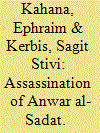

|
|
|
|
|
| Publication |
2014.
|
| Summary/Abstract |
Within the context of intelligence, the assassination of Egypt's President Muhammad Anwar al-Sadat on 6 October 1981 can be characterized as both a symbolic security failure and a failure to implement professional security principles by those responsible for guarding his life.
The circumstances creating the security "hole" were not confined to the short period preceding the assassination, but rather began long before, as part of an intense clash between two conflicting forces: extreme Islam and modern statehood.
In contrast to prevailing opinion, the apex of the struggle between these two forces is the main reason for the assassination, and not Sadat's peace with Israel. 1 The assassins of the al-Jihad group, springing unchecked from the substratum of fundamentalist Islam, carried out their work resolutely, exploiting the circumstances with almost incredible ease.
The sixth of October, observed in Egypt as a day of military triumph over the Israel Defense Forces (IDF) in the October 1973 War (the Yom Kippur War), is celebrated as an official holiday at the Grave of the Unknown Soldier on the outskirts of Cairo. On that date in 1981, on the reviewing stand stood President Sadat and his entourage: Vice President Hosni Mubarak; Defense Minister Mohammad Abu-Gazala; members of parliament; and members of the diplomatic corps, among them Israeli Ambassador Moshe Sassón.
Mirage fighter planes flew in celebratory formation above, and all in attendance were occupied with watching them and the huge parade passing before the reviewing stand, as columns of soldiers marched past the proud president.
When it was the artillery unit's turn to pass, a military truck stopped suddenly, from which four uniformed men sprang. Thinking this was part of the pageantry, no security personnel acted to prevent them from approaching the reviewing stand. One of the men quickly threw a grenade that did not explode, followed by more grenades. The assassins cocked their weapons and charged, firing at those on the reviewing stand.
The speed and suddenness with which the assassination was carried out resulted in pandemonium. People ran in all directions to take cover while Sadat stood, stiff and in shock, making him a clear target for sniper Hussein Abbas, 2 who shot him in the neck and chest. Sadat collapsed on the spot, yet this did not prevent another assassin, Abed al-Hamid, from emptying the rest of his rifle's magazine unhindered to confirm the kill. Sadat was flown by Gazelle helicopter to the Armed Forces Military Hospital at Ma'adi, but he arrived with no pulse, as his chest and arteries had been fatally penetrated.
The individual responsible for the assassination was Captain Khalid al-Islambouli. The fact that he and his partners managed to carry out this "inside job," despite explicit warnings having been received of threats on the president's life at the parade, testifies to a complete absence of common sense on the part of the Egyptian security sector.
The head of the Israeli security unit and lead investigator of the assassination, who was also responsible for Ambassador Sasson's rescue, was Avraham Rotem. According to Rotem, some members of Sadat's security detail were known to Rotem's unit personally due to previous reciprocal visits between Israeli and Egyptian personnel. 3 For this reason, the part played by Egyptian security personnel that day remains a mystery, due precisely to Israel's familiarity with them and the fact that they had acquired their security expertise from the best American instructional training. Sadat's assassination therefore raises a number of burning questions emanating from the fact that many in the upper Egyptian echelons knew that Sadat was in the opposition's crosshairs.
|
|
|
|
|
|
|
|
|
|
|
|
|
|
|
|
| 2 |
ID:
130231
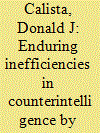

|
|
|
|
|
| Publication |
2014.
|
| Summary/Abstract |
A lot of time we are chasing shadows, but it's better to do that than find out later you let something get by. (An FBI field agent-Type I Error or a false positive). 1
The best chance for success [terrorists] have is to get somebody who is not a visitor [to] come in as a permanent resident or citizen, who knows the culture and how to move around, who doesn't have a record, so as not to get picked up by a database. (A former senior U.S. intelligence official-Type II Error or a false negative). 2
These two citations reflect divergent responses to the governance structures of terror organizations that continue to be subjects of interest and debate among scholars and practitioners. The operational character of terrorism remains essential to the development of strategic initiatives by counterintelligence (CI) agencies. To position CI more advantageously certain concepts from New Institutional Economics (NIE) might be utilized. 3 NIE's central formulation of principals and agents assumes that people make rational choices in determining whether to plan their transactions (relationship costs) into one of two kinds of configurations: market (decentralized) versus non-market (centralized) endeavors. Effectively, the challenge is to determine which transactional method offers greater prospects to achieve efficiency. Inherent limitations (externalities) of time, place and resources complicate these choices. Those involved can be divided into owners (principals) and workers or suppliers (agents). In fulfilling any agreed upon duties, transaction costs then center on the degree to which principals undertake monitoring the behavior of agents for possible shirking-referenced by NIE as the "agency problem."
|
|
|
|
|
|
|
|
|
|
|
|
|
|
|
|
| 3 |
ID:
130233
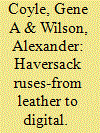

|
|
|
|
|
| Publication |
2014.
|
| Summary/Abstract |
The historical record of a country allowing false documents to fall into the hands of its enemy in order to deceive him goes back at least as far as the third century B.C., when Hannibal fought the Romans. 1 Yet, the ploy of misleading an enemy through the "passage" of fake documents to the other side probably reached its zenith during the twentieth century's First and Second World Wars, especially with a few spectacular cases involving an allegedly wounded courier and, once, even a dead one. Because of the famous British deception ploy in Palestine against the Turks in 1917, most all such deceptions came to be known as "haversack ruses." The king of all such ruses, at least in terms of being the best-known through numerous books and even a movie, was Operation MINCEMEAT of World War II. This elaborate British ploy of 1943 employed a dead body, a submarine to deliver it off the coast of Spain, false documents to deceive Germany's Adolf Hitler about the date and location of an anticipated Allied invasion of southern Europe, and the painstaking creation and backstopping of "The Man Who Never Was."
The purpose of examining variations of this type of ruse is to determine if these ploys featured any common characteristics, as well as any commonality in the backgrounds and personalities of the people who came up with or implemented such ideas. Did they include traits that make for a good deception officer? One of the World War II "deceivers," Sefton Delmer, wrote years later that, in wartime London, many of his most successful deception ideas came to him while drinking vintage champagne at Frascati's, his favorite expensive restaurant with its plush chairs and elderly waiters. 2
At first glance, the haversack ruses seem to have ended with the close of World War II, but perhaps the medium simply changed from leather satchels to digital ones. The challenge of looking at relatively recent "digital haversack" deceptions is that most instances remain classified, but a few Western ploys against the Soviet Union in the early 1980s have entered the public domain. The delivery methods of modern deceptions have changed, but the goal of misleading the enemy is still the same. Although no exciting tales involving dead bodies have surfaced-just the use of dull digital zeros and ones from computer files-the results may occasionally be equally exciting. And the need still exists for imaginative, operational minds in today's deception operations.
|
|
|
|
|
|
|
|
|
|
|
|
|
|
|
|
| 4 |
ID:
130229
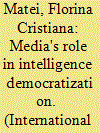

|
|
|
|
|
| Publication |
2014.
|
| Summary/Abstract |
In their path toward democratic consolidation, emerging democracies endeavor to ensure the democratic transfer of political power, bring changes in the legal framework, transform their executive, legislative, and judicial systems, boost free market economy, and develop robust and functional civil societies. They also institutionalize democratic civil-military relations (CMR) by establishing new security institutions-military, police, and intelligence agencies-that are under democratic civilian control, effective, and efficient. Of these many tasks, the democratization of intelligence agencies is by far the most daunting, as effectiveness and efficiency involve secrecy, while democratic control implies transparency, openness, and accountability. Nevertheless, democratic reform of intelligence in new democracies, though difficult, is not impossible, if and when civilians are interested and willing to "invest" in intelligence and intelligence reform. The contribution of external factors, such as media, 2 civil society, international groups, and individuals involved in human rights, may also be instrumental in achieving a balance between control and effectiveness of intelligence
|
|
|
|
|
|
|
|
|
|
|
|
|
|
|
|
| 5 |
ID:
130224
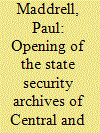

|
|
|
|
|
| Publication |
2014.
|
| Summary/Abstract |
Laws passed since 1991 1 have opened the state security archives of the former Communist states of Central and Eastern Europe. Such legislation is in place throughout the former Soviet Bloc, but the focus here is on the opening of the German and Romanian archives. The process is far advanced in Germany and much less so in Romania. The contrast between the two very well displays the issues involved.
The opening of the archives has been an important tool of de-Communization. The process has been fullest in Germany because of the strength and self-confidence of the German legal system and because of the weakness of the Communists' political position. It has been partial in Romania because the legal system there lacks authority, independence, and self-confidence, and the Communists have remained strong.
Important differences exist between the various former Soviet bloc countries, but, generally speaking, the institutions which now hold the Communist-era state security records have four tasks:
1. to enable the connections of public officials with the former Communist security and intelligence services to be investigated so that those who collaborated with those services can be removed from public office ("lustration," as it is called);
2. to make available to targets of Communist-era surveillance and repression the records held on them;
3. to make records available for the prosecution of those who committed crimes during the period of Communist rule; and
4. to enable historians and journalists to write the history of Communist surveillance and repression more accurately and fully.
These four tasks serve the purposes of building stable democratic institutions which enjoy public trust, and of giving victims of the Communist security services a measure of retrospective justice.
|
|
|
|
|
|
|
|
|
|
|
|
|
|
|
|
| 6 |
ID:
130227
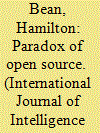

|
|
|
|
|
| Publication |
2014.
|
| Summary/Abstract |
The Associated Press (AP) reported on 8 November 2005 that, as part of post-11 September 2001 (9/11) United States intelligence reform efforts, the Director of National Intelligence (DNI) had established the Open Source Center (OSC). 1 Then-Director of the Central Intelligence Agency (CIA), former Florida congressman Porter Goss, described the OSC as a "major strategic initiative and commitment to the value we place on openly available information." 2 Challenging Goss's statement of commitment, the AP asserted that the OSC had actually been created, in part, in order to "elevate a brand of information [open source] that's long been a stepchild in the U.S. spy community." 3 Directed to "collect and study information that's publicly available around the world, including media reports, Internet postings and even T-shirts in Southeast Asia," 4 the OSC described itself as "the US Government's premier provider of foreign open source intelligence." 5 Visitors to the OpenSource.gov Website were told that the OSC offered authorized government employees and contractors "information on foreign political, military, economic, and technical issues beyond the usual media from an ever expanding universe of open sources
|
|
|
|
|
|
|
|
|
|
|
|
|
|
|
|
| 7 |
ID:
130225
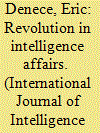

|
|
|
|
|
| Publication |
2014.
|
| Summary/Abstract |
That a "Revolution in Military Affairs" (RMA) took place in the early 1990s is widely known. The concept was born of technological, political, social, and economic changes that were to fundamentally alter the future of warfare, introducing a completely new type of military and organizational structure for the effective projection of force.
Though most experts accepted the reality of a fundamental transformation in the practice of warfare, few saw that a parallel revolution was occurring in the intelligence world, even though this specific field of national security was undergoing similar challenges and change.
That a "Revolution in Intelligence Affairs" in the 1990s and early 2000s actually occurred and its effects has become increasingly evident. This "intelligence revolution" resulted from a combination of changes in international politics, information technologies, and socio-political context.
|
|
|
|
|
|
|
|
|
|
|
|
|
|
|
|
| 8 |
ID:
130228
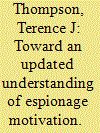

|
|
|
|
|
| Publication |
2014.
|
| Summary/Abstract |
The case of Edward Snowden, who in May 2013 revealed a huge number of National Security Agency codes, has again raised the question of motivation in espionage and disclosure of documents.
Espionage is a crime with complex, multi-faceted motivational factors that do not lend themselves to easy explanation. Most cases present a singular mosaic of intersecting psychosocial forces which culminate in a decision to engage in the crime. Espionage is committed by individuals from the lower middle to upper middle classes; unlike street crime, it is rarely, if ever, committed by the poor. What drives people of middle class privilege to choose to commit such a heinous crime?
The current model, postulated by numerous scholars and simplified here, holds that espionage occurs at the collision of an opportunity, a perceived life crisis, and a moral failing, which is then actuated by a trigger. 1 The spy must have an opportunity, which usually translates into access to information or a person. Access to information is typically gained through the holding of a security clearance. Such a trusted insider has minimally restrained access to classified information, and that access is usually defined by position. A senior scientist working on satellite systems obviously has significant access to classified satellite data but may have almost no access to human intelligence (HUMINT)-and vice versa. Conversely, and perhaps surprisingly, according to one study, 25 percent of known spies since World War II have held no security clearance. 2 These spies usually acted in concert with another individual (often a spouse or lover), or simply knew someone who did have access. This was the case in the Boyce-Lee case in California wherein Christopher Boyce held a security clearance and Dalton Lee did not. 3 Access, however derived, represents the most common opportunity to commit espionage.
|
|
|
|
|
|
|
|
|
|
|
|
|
|
|
|
| 9 |
ID:
130232
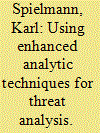

|
|
|
|
|
| Publication |
2014.
|
| Summary/Abstract |
This is intended as an instructional supplement to a methodology I proposed in my earlier article "Strengthening Intelligence Threat Analysis." 1 Through the presentation of a hypothetical case study, I hope to facilitate analysts' use of that proposed methodology by walking them through the major tests that comprise its assessment process.
Accurately determining the nature and likelihood of a threat from terrorists or state actors can be very difficult, with high costs for failure. This proposed methodology is a tool to help analysts better provide clear, timely, and well-substantiated warning to key decisionmakers. Its assessment process has three tests, which build on each other to determine the strengths and weaknesses of different possible views on a threat. The first two tests yield important interim results, affording early intelligence inputs for decisionmaking. When completed, the testing provides a numerical basis for ranking competing views, enabling more precise and transparent judgments to be made on a threat's probability than is common practice.
|
|
|
|
|
|
|
|
|
|
|
|
|
|
|
|
|
|
|
|
|